Papers
My research papers in reversed chronological order. All papers can be found in my arXiv page.
-
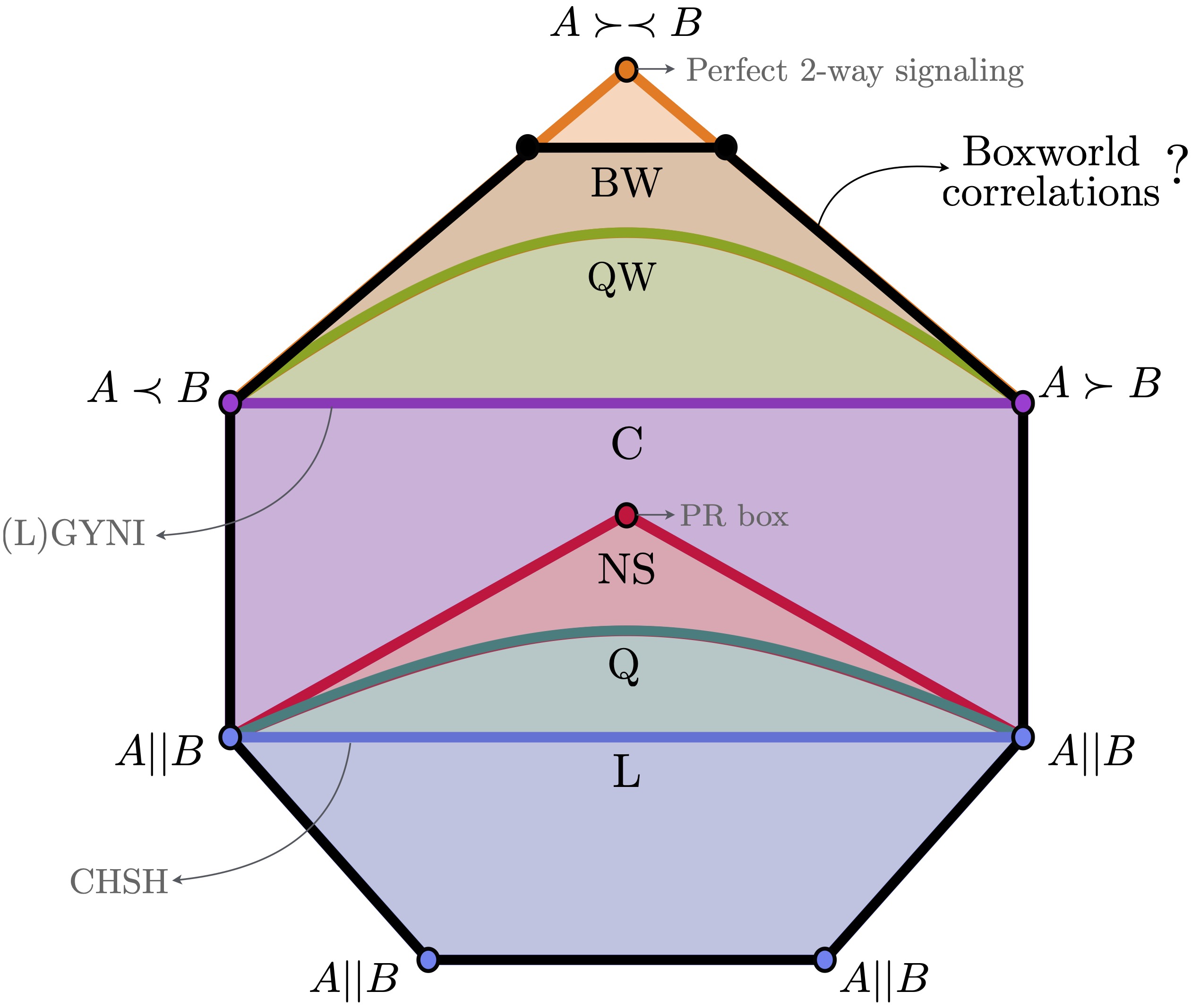 Indefinite causal order in boxworld theoriesJessica Bavaresco, Ämin Baumeler, Yelena Guryanova, Costantino Budroni
Indefinite causal order in boxworld theoriesJessica Bavaresco, Ämin Baumeler, Yelena Guryanova, Costantino BudroniAn astonishing feature of higher-order quantum theory is that it can accommodate indefinite causal order. In the simplest bipartite setting, there exist signaling correlations for which it is fundamentally impossible to ascribe a definite causal order for the parties’ actions. Moreover, the assumptions required to arrive at such a statement (local quantum transformations and well-behaved probabilities) result in a nontrivial set of correlations, whose boundary is, to date, uncharacterized. In this work, we investigate indefinite causal order in boxworld theories. We construct a higher-order theory whose descriptor is the generalized bit (gbit)—the natural successor of the classical bit and quantum qubit. By fixing the local transformations in boxworld and asking about the global causal structure, we find that we trivially recover the full set of two-way signaling correlations. In light of this, we motivate and propose two physical principles in order to limit the set of achievable correlations: nonsignaling preservation and no signaling without system exchange. We find that a higher-order boxworld theory that respects these physical principles leads to (i) a nontrivial set of achievable correlations and (ii) a violation of some causal inequalities that is higher than what can be achieved in higher-order quantum theory. These results lead us to conjecture that the set of correlations of our higher-order boxworld theory is an outer approximation to the set of correlations produced by higher-order quantum theory.
-
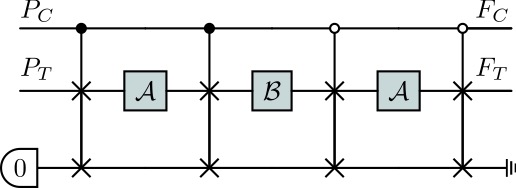 Exponential separation in quantum query complexity of the quantum switch with respect to simulations with standard quantum circuitsHlér Kristjánsson, Tatsuki Odake, Satoshi Yoshida, Philip Taranto, Jessica Bavaresco, Marco Túlio Quintino, Mio Murao
Exponential separation in quantum query complexity of the quantum switch with respect to simulations with standard quantum circuitsHlér Kristjánsson, Tatsuki Odake, Satoshi Yoshida, Philip Taranto, Jessica Bavaresco, Marco Túlio Quintino, Mio MuraoQuantum theory is consistent with a computational model permitting black-box operations to be applied in an indefinite causal order, going beyond the standard circuit model of computation. The quantum switch—the simplest such example—has been shown to provide numerous information-processing advantages. Here, we prove that the action of the quantum switch on two n-qubit quantum channels cannot be simulated deterministically and exactly by any causally ordered quantum circuit that uses M calls to one channel and one call to the other, if M≤max(2,2^n-1). This demonstrates an exponential separation in quantum query complexity of indefinite causal order compared to standard quantum circuits.
-
 Can the quantum switch be deterministically simulated?Jessica Bavaresco, Satoshi Yoshida, Tatsuki Odake, Hlér Kristjánsson, Philip Taranto, Mio Murao, Marco Túlio Quintino
Can the quantum switch be deterministically simulated?Jessica Bavaresco, Satoshi Yoshida, Tatsuki Odake, Hlér Kristjánsson, Philip Taranto, Mio Murao, Marco Túlio QuintinoHigher-order transformations that act on a certain number of input quantum channels in an indefinite causal order—such as the quantum switch—cannot be described by standard quantum circuits that use the same number of calls of the input quantum channels. However, the question remains whether they can be simulated, i.e., whether their action on their input channels can be deterministically reproduced, for all arbitrary inputs, by a quantum circuit that uses a larger number of calls of the input channels. Here, we prove that when only one extra call of each input channel is available, the quantum switch cannot be simulated by any quantum circuit. We demonstrate that this result is robust by showing that, even when probabilistic and approximate simulations are considered, higher-order transformations that are close to the quantum switch can be at best simulated with a probability strictly less than one. This result stands in stark contrast with the known fact that, when the quantum switch acts exclusively on unitary channels, its action can be simulated.
-
 Designing optimal protocols in Bayesian quantum parameter estimation with higher-order operationsJessica Bavaresco, Patryk Lipka-Bartosik, Pavel Sekatski, Mohammad MehboudiPhysical Review Research 6, 023305 (2024)
Designing optimal protocols in Bayesian quantum parameter estimation with higher-order operationsJessica Bavaresco, Patryk Lipka-Bartosik, Pavel Sekatski, Mohammad MehboudiPhysical Review Research 6, 023305 (2024)Using quantum systems as sensors or probes has been shown to greatly improve the precision of parameter estimation by exploiting unique quantum features such as entanglement. A major task in quantum sensing is to design the optimal protocol, i.e., the most precise one. It has been solved for some specific instances of the problem, but in general even numerical methods are not known. Here, we focus on the single-shot Bayesian setting, where the goal is to find the optimal initial state of the probe (which can be entangled with an auxiliary system), the optimal measurement, and the optimal estimator function. We leverage the formalism of higher-order operations to develop a method based on semidefinite programming that finds a protocol that is close to the optimal one with arbitrary precision. Crucially, our method is not restricted to any specific quantum evolution, cost function or prior distribution, and thus can be applied to any estimation problem. Moreover, it can be applied to both single or multiparameter estimation tasks. We demonstrate our method with three examples, consisting of unitary phase estimation, thermometry in a bosonic bath, and multiparameter estimation of an SU(2) transformation. Exploiting our methods, we extend several results from the literature. For example, in the thermometry case, we find the optimal protocol at any finite time and quantify the usefulness of entanglement. Additionally, we show that when the cost function is the mean squared error, projective measurements are optimal for estimation.
-
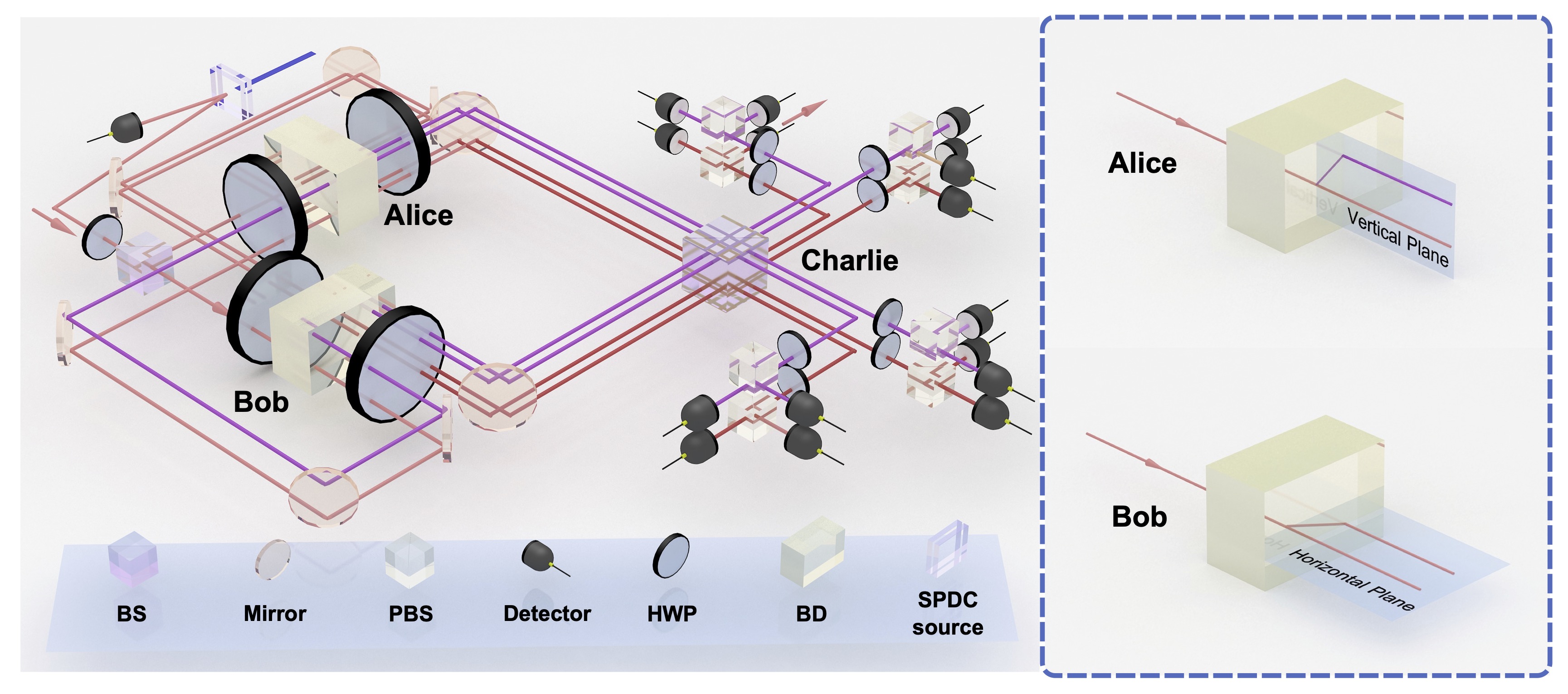 Semi-device-independent certification of indefinite causal order in a photonic quantum switchHuan Cao, Jessica Bavaresco, Ning-Ning Wang, Lee A. Rozema, Chao Zhang, Yun-Feng Huang, Bi-Heng Liu, Chuan-Feng Li, Guang-Can Guo, Philip WaltherOptica 10, 561–568 (2023)
Semi-device-independent certification of indefinite causal order in a photonic quantum switchHuan Cao, Jessica Bavaresco, Ning-Ning Wang, Lee A. Rozema, Chao Zhang, Yun-Feng Huang, Bi-Heng Liu, Chuan-Feng Li, Guang-Can Guo, Philip WaltherOptica 10, 561–568 (2023)Quantum processes are transformations that act on quantum operations. Their study led to the discovery of the phenomenon of indefinite causal order: some quantum processes, such as the quantum switch, act on independent quantum operations in such a way that the order in which the operations are acted upon not only cannot be determined but is simply undefined. This is the property that we experimentally certify in this work. We report an experimental certification of indefinite causal order that relies only on the characterization of the operations of a single party. We do so in the semi-device-independent scenario with the fewest possible assumptions of characterization of the parties’ local operations in which indefinite causal order can be demonstrated with the quantum switch. To achieve this result, we introduce the concept of semi-device-independent causal inequalities and show that the correlations generated in a photonic quantum switch, in which all parties are able to collect local outcome statistics, achieve a violation of this inequality of 224 standard deviations. This result consists of the experimental demonstration of indefinite causal order with the fewest device-characterization assumptions to date.
-
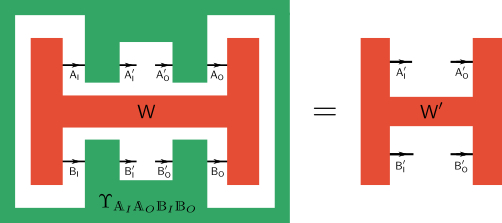 Resource theory of causal connectionSimon Milz, Jessica Bavaresco, Giulio ChiribellaQuantum 6, 788 (2022)
Resource theory of causal connectionSimon Milz, Jessica Bavaresco, Giulio ChiribellaQuantum 6, 788 (2022)The capacity of distant parties to send signals to one another is a fundamental requirement in many information-processing tasks. Such ability is determined by the causal structure connecting the parties, and more generally, by the intermediate processes carrying signals from one laboratory to another. Here we build a fully fledged resource theory of causal connection for all multi-party communication scenarios, encompassing those where the parties operate in a definite causal order and also where the order is indefinite. We define and characterize the set of free processes and three different sets of free transformations thereof, resulting in three distinct resource theories of causal connection. In the causally ordered setting, we identify the most resourceful processes in the bipartite and tripartite scenarios. In the general setting, instead, our results suggest that there is no global most valuable resource. We establish the signalling robustness as a resource monotone of causal connection and provide tight bounds on it for many pertinent sets of processes. Finally, we introduce a resource theory of causal non-separability, and show that it is ? in contrast to the case of causal connection ? unique. Together our results offer a flexible and comprehensive framework to quantify and transform general quantum processes, as well as insights into their multi-layered causal connection structures.
-
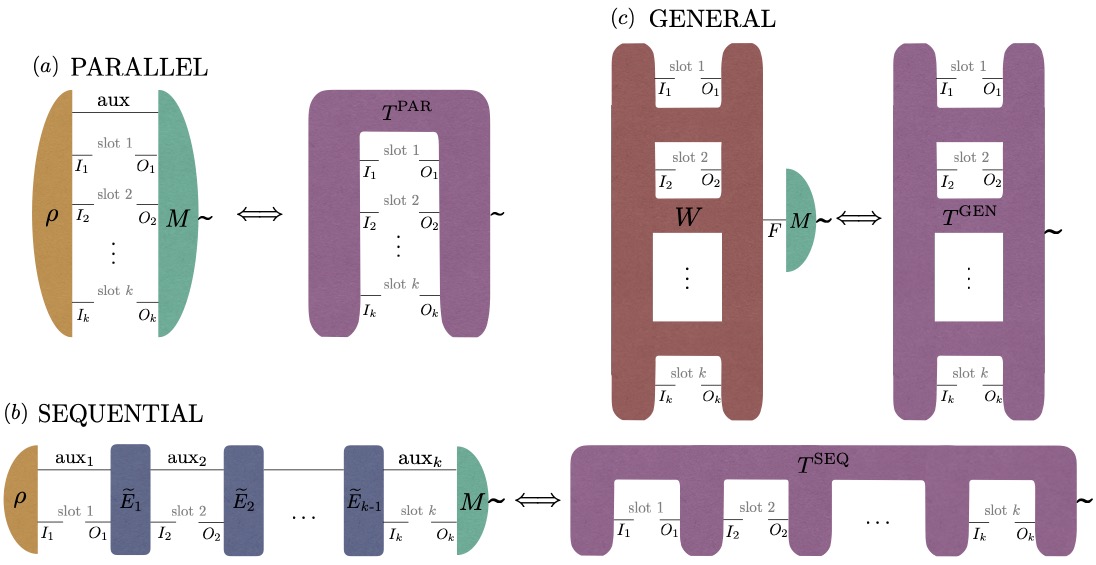 Unitary channel discrimination beyond group structures: Advantages of sequential and indefinite-causal-order strategiesJessica Bavaresco, Mio Murao, Marco Túlio QuintinoJournal of Mathematical Physics 63, 042203 (2022)
Unitary channel discrimination beyond group structures: Advantages of sequential and indefinite-causal-order strategiesJessica Bavaresco, Mio Murao, Marco Túlio QuintinoJournal of Mathematical Physics 63, 042203 (2022)For minimum-error channel discrimination tasks that involve only unitary channels, we show that sequential strategies may outperform the parallel ones. Additionally, we show that general strategies that involve indefinite causal order are also advantageous for this task. However, for the task of discriminating a uniformly distributed set of unitary channels that forms a group, we show that parallel strategies are, indeed, optimal, even when compared to general strategies. We also show that strategies based on the quantum switch cannot outperform sequential strategies in the discrimination of unitary channels. Finally, we derive an absolute upper bound for the maximal probability of successfully discriminating any set of unitary channels with any number of copies for the most general strategies that are suitable for channel discrimination. Our bound is tight since it is saturated by sets of unitary channels forming a group k-design.
-
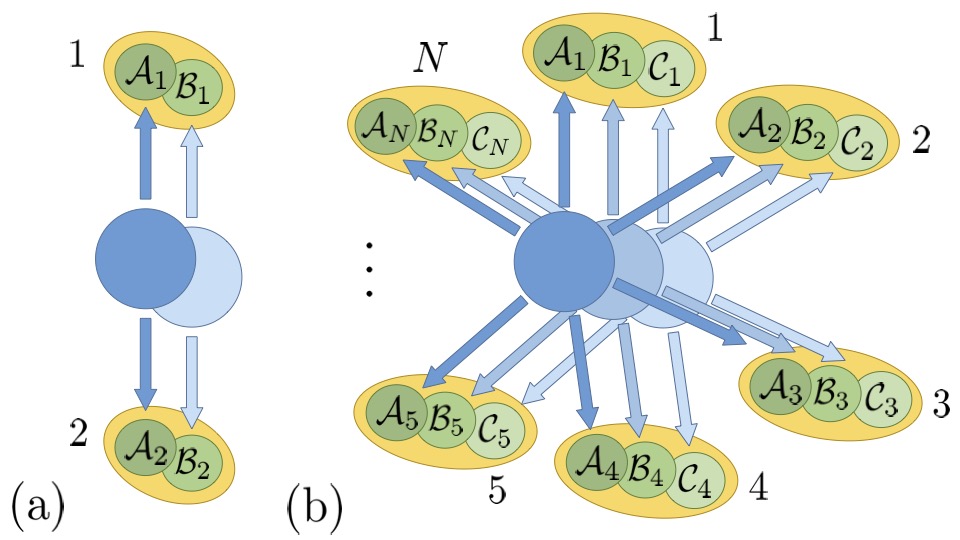 Activation of genuine multipartite entanglement: Beyond the single-copy paradigm of entanglement characterisationHayata Yamasaki, Simon Morelli, Markus Miethlinger, Jessica Bavaresco, Nicolai Friis, Marcus HuberQuantum 6, 695 (2022)
Activation of genuine multipartite entanglement: Beyond the single-copy paradigm of entanglement characterisationHayata Yamasaki, Simon Morelli, Markus Miethlinger, Jessica Bavaresco, Nicolai Friis, Marcus HuberQuantum 6, 695 (2022)Entanglement shared among multiple parties presents complex challenges for the characterisation of different types of entanglement. One of the most fundamental insights is the fact that some mixed states can feature entanglement across every possible cut of a multipartite system yet can be produced via a mixture of states separable with respect to different partitions. To distinguish states that genuinely cannot be produced from mixing such partition-separable states, the term genuine multipartite entanglement was coined. All these considerations originate in a paradigm where only a single copy of the state is distributed and locally acted upon. In contrast, advances in quantum technologies prompt the question of how this picture changes when multiple copies of the same state become locally accessible. Here we show that multiple copies unlock genuine multipartite entanglement from partially separable states, i.e., mixtures of the partition-separable states, even from undistillable ensembles, and even more than two copies can be required to observe this effect. With these findings, we characterise the notion of genuine multipartite entanglement in the paradigm of multiple copies and conjecture a strict hierarchy of activatable states and an asymptotic collapse of the hierarchy.
-
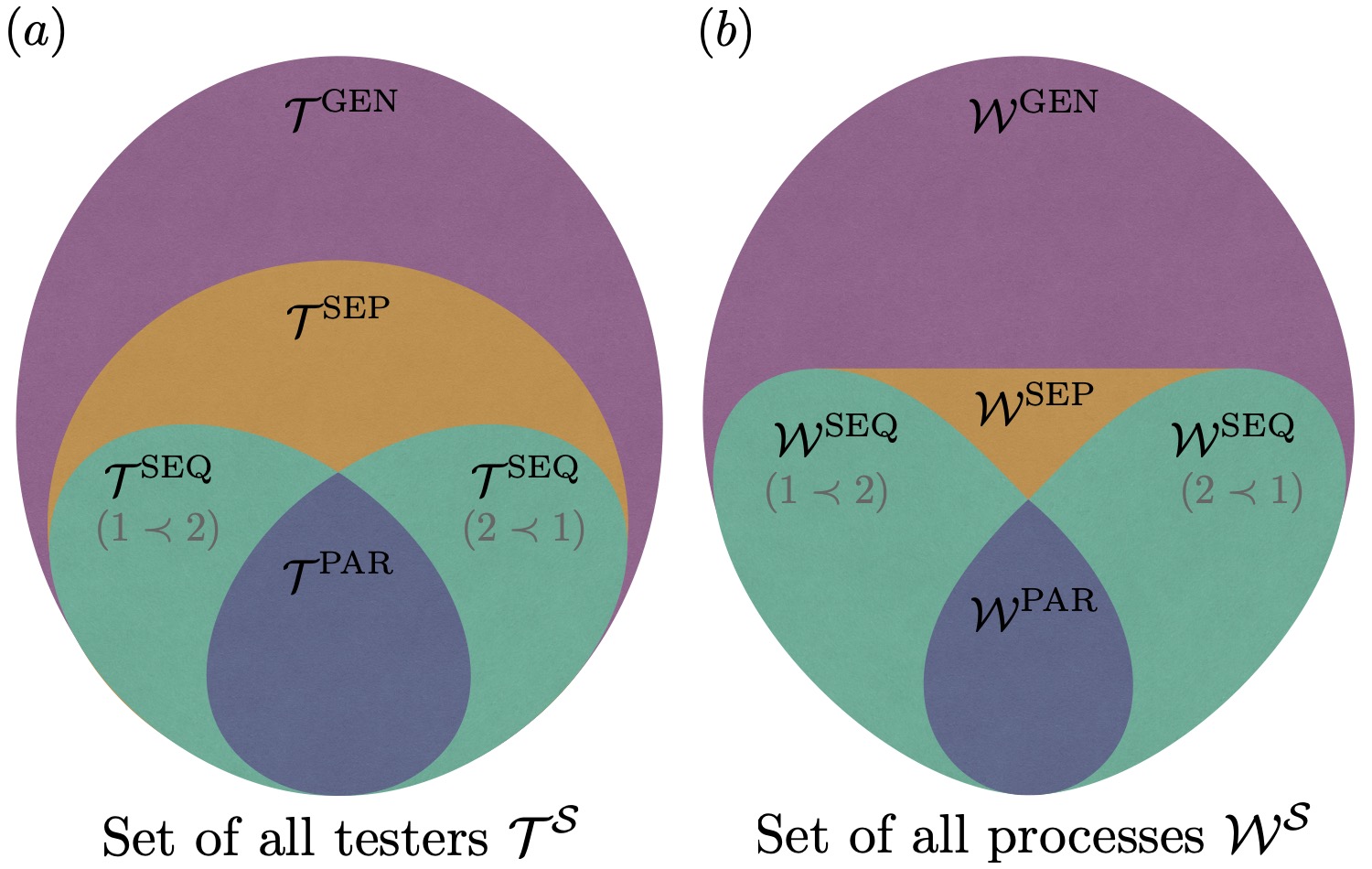 Strict Hierarchy between Parallel, Sequential, and Indefinite-Causal-Order Strategies for Channel DiscriminationJessica Bavaresco, Mio Murao, Marco Túlio QuintinoPhysical Review Letters 127, 200504 (2021)
Strict Hierarchy between Parallel, Sequential, and Indefinite-Causal-Order Strategies for Channel DiscriminationJessica Bavaresco, Mio Murao, Marco Túlio QuintinoPhysical Review Letters 127, 200504 (2021)We present an instance of a task of minimum-error discrimination of two qubit-qubit quantum channels for which a sequential strategy outperforms any parallel strategy. We then establish two new classes of strategies for channel discrimination that involve indefinite causal order and show that there exists a strict hierarchy among the performance of all four strategies. Our proof technique employs a general method of computer-assisted proofs. We also provide a systematic method for finding pairs of channels that showcase this phenomenon, demonstrating that the hierarchy between strategies is not exclusive to our main example.
-
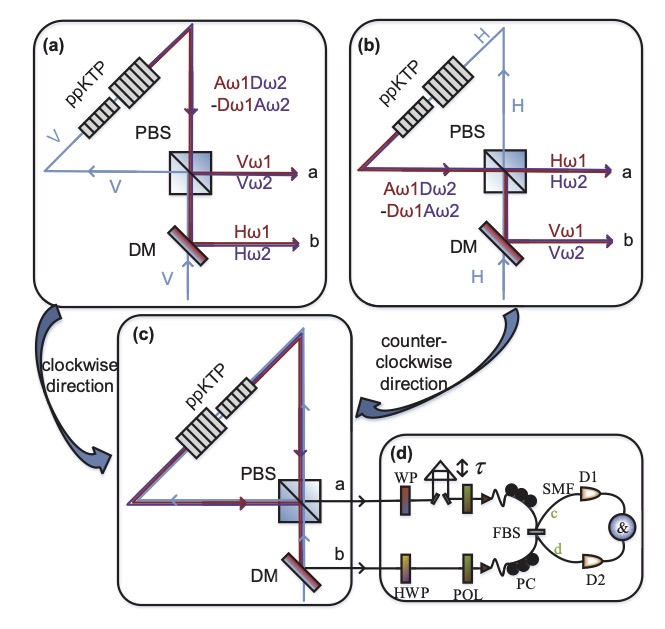 Verification of high-dimensional entanglement generated in quantum interferenceYuanyuan Chen, Sebastian Ecker, Jessica Bavaresco, Thomas Scheidl, Lixiang Chen, Fabian Steinlechner, Marcus Huber, Rupert UrsinPhysical Review A 101, 032302 (2020)
Verification of high-dimensional entanglement generated in quantum interferenceYuanyuan Chen, Sebastian Ecker, Jessica Bavaresco, Thomas Scheidl, Lixiang Chen, Fabian Steinlechner, Marcus Huber, Rupert UrsinPhysical Review A 101, 032302 (2020)Entanglement and quantum interference are key ingredients in a variety of quantum information processing tasks. Harnessing the generation and characterization of entanglement in high-dimensional state spaces is a necessary prerequisite towards practical quantum protocols. Here, we use quantum interference on a beam splitter to engineer hyperentanglement in polarization and discrete frequency degrees of freedom (DOF). We show how independent measurements of polarization and frequency DOF allow for the verification of high-dimensional entanglement in the combined state space. These results may indicate new paths towards practical exploitation of entanglement stored in multiple degrees of freedom, in particular in the context of high-dimensional quantum information processing protocols.
-
 Semi-device-independent certification of indefinite causal orderJessica Bavaresco, Mateus Araújo, Časlav Brukner, Marco Túlio QuintinoQuantum 3, 176 (2019)
Semi-device-independent certification of indefinite causal orderJessica Bavaresco, Mateus Araújo, Časlav Brukner, Marco Túlio QuintinoQuantum 3, 176 (2019)When transforming pairs of independent quantum operations according to the fundamental rules of quantum theory, an intriguing phenomenon emerges: some such higher-order operations may act on the input operations in an indefinite causal order. Recently, the formalism of process matrices has been developed to investigate these noncausal properties of higher-order operations. This formalism predicts, in principle, statistics that ensure indefinite causal order even in a device-independent scenario, where the involved operations are not characterised. Nevertheless, all physical implementations of process matrices proposed so far require full characterisation of the involved operations in order to certify such phenomena. Here we consider a semi-device-independent scenario, which does not require all operations to be characterised. We introduce a framework for certifying noncausal properties of process matrices in this intermediate regime and use it to analyse the quantum switch, a well-known higher-order operation, to show that, although it can only lead to causal statistics in a device-independent scenario, it can exhibit noncausal properties in semi-device-independent scenarios. This proves that the quantum switch generates stronger noncausal correlations than it was previously known.
-
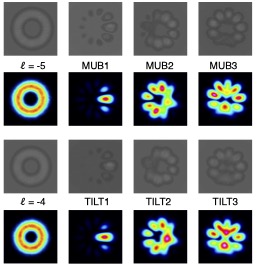 Measurements in two bases are sufficient for certifying high-dimensional entanglementJessica Bavaresco, Natalia Herrera Valencia, Claude Klöckl, Matej Pivoluska, Paul Erker, Nicolai Friis, Mehul Malik, Marcus HuberNature Physics 14, 1032 (2018)
Measurements in two bases are sufficient for certifying high-dimensional entanglementJessica Bavaresco, Natalia Herrera Valencia, Claude Klöckl, Matej Pivoluska, Paul Erker, Nicolai Friis, Mehul Malik, Marcus HuberNature Physics 14, 1032 (2018)High-dimensional encoding of quantum information provides a way of transcending the limitations of current approaches to quantum communication, which are mostly based on the entanglement between qubits—two-dimensional quantum systems. One of the central challenges in the pursuit of high-dimensional alternatives is ascertaining the presence of high-dimensional entanglement within a given high-dimensional quantum state. In particular, it would be desirable to carry out such entanglement certification without resorting to inefficient full state tomography. Here, we show how carefully constructed measurements in two bases (one of which is not orthonormal) can be used to faithfully and efficiently certify bipartite high-dimensional states and their entanglement for any physical platform. To showcase the practicality of this approach under realistic conditions, we put it to the test for photons entangled in their orbital angular momentum. In our experimental set-up, we are able to verify 9-dimensional entanglement for a pair of photons on a 11-dimensional subspace each, at present the highest amount certified without any assumptions on the state.
-
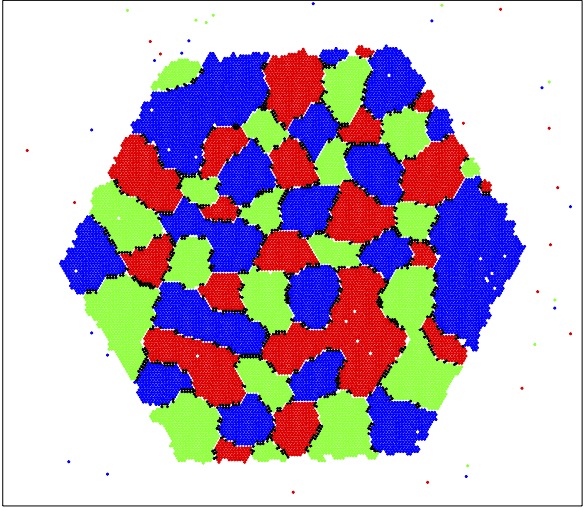 Simulations of submonolayer Xe on Pt(111): The case for a chaotic low temperature phaseAnthony D. Novaco, Jessica BavarescoJournal of Chemical Physics 148, 144704 (2018)
Simulations of submonolayer Xe on Pt(111): The case for a chaotic low temperature phaseAnthony D. Novaco, Jessica BavarescoJournal of Chemical Physics 148, 144704 (2018)Molecular dynamics simulations are reported for the structural and thermodynamic properties of submonolayer xenon adsorbed on the (111) surface of platinum for temperatures up to the (apparently incipient) triple point and beyond. While the motion of the atoms in the surface plane is treated with a standard two-dimensional molecular dynamics simulation, the model takes into consideration the thermal excitation of quantum states associated with surface-normal dynamics in an attempt to describe the apparent smoothing of the corrugation with increasing temperature. We examine the importance of this thermal smoothing to the relative stability of several observed and proposed low-temperature structures. Structure factor calculations are compared to experimental results in an attempt to determine the low temperature structure of this system. These calculations provide strong evidence that, at very low temperatures, the domain wall structure of a xenon monolayer adsorbed on a Pt(111) substrate possesses a chaotic-like nature, exhibiting long-lived meta-stable states with pinned domain walls, these walls having narrow widths and irregular shapes. This result is contrary to the standard wisdom regarding this system, namely, that the very low temperature phase of this system is a striped incommensurate phase. We present the case for further experimental investigation of this and similar systems as possible examples of chaotic low temperature phases in two dimensions.
-
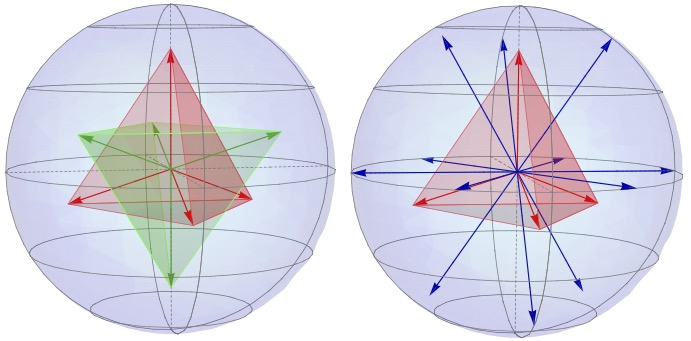 Operational framework for quantum measurement simulabilityLeonardo Guerini, Jessica Bavaresco, Marcelo Terra Cunha, Antonio AcínJournal of Mathematical Physics 58, 092102 (2017)
Operational framework for quantum measurement simulabilityLeonardo Guerini, Jessica Bavaresco, Marcelo Terra Cunha, Antonio AcínJournal of Mathematical Physics 58, 092102 (2017)We introduce a framework for simulating quantum measurements based on classical processing of a set of accessible measurements. Well-known concepts such as joint measurability and projective simulability naturally emerge as particular cases of our framework, but our study also leads to novel results and questions. First, a generalisation of joint measurability is derived, which yields a hierarchy for the incompatibility of sets of measurements. A similar hierarchy is defined based on the number of outcomes necessary to perform a simulation of a given measurement. This general approach also allows us to identify connections between different kinds of simulability and, in particular, we characterise the qubit measurements that are projective-simulable in terms of joint measurability. Finally, we discuss how our framework can be interpreted in the context of resource theories.
-
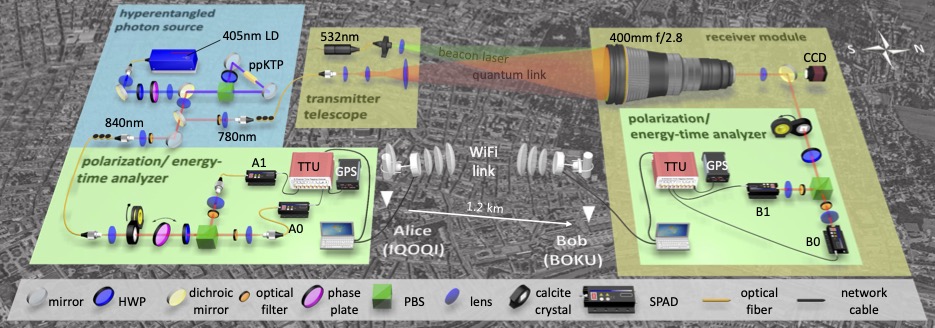 Distribution of high-dimensional entanglement via an intra-city free-space linkFabian Steinlechner, Sebastian Ecker, Matthias Fink, Bo Liu, Jessica Bavaresco, Marcus Huber, Thomas Scheidl, Rupert UrsinNature Communications 8, 15971 (2017)
Distribution of high-dimensional entanglement via an intra-city free-space linkFabian Steinlechner, Sebastian Ecker, Matthias Fink, Bo Liu, Jessica Bavaresco, Marcus Huber, Thomas Scheidl, Rupert UrsinNature Communications 8, 15971 (2017)Quantum entanglement is a fundamental resource in quantum information processing and its distribution between distant parties is a key challenge in quantum communications. Increasing the dimensionality of entanglement has been shown to improve robustness and channel capacities in secure quantum communications. Here we report on the distribution of genuine high-dimensional entanglement via a 1.2-km-long free-space link across Vienna. We exploit hyperentanglement, that is, simultaneous entanglement in polarization and energy-time bases, to encode quantum information, and observe high-visibility interference for successive correlation measurements in each degree of freedom. These visibilities impose lower bounds on entanglement in each subspace individually and certify four-dimensional entanglement for the hyperentangled system. The high-fidelity transmission of high-dimensional entanglement under real-world atmospheric link conditions represents an important step towards long-distance quantum communications with more complex quantum systems and the implementation of advanced quantum experiments with satellite links.
-
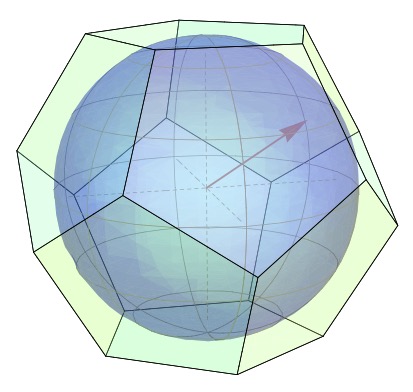 Most incompatible measurements for robust steering testsJessica Bavaresco, Marco Túlio Quintino, Leonardo Guerini, Thiago O. Maciel, Daniel Cavalcanti, Marcelo Terra CunhaPhysical Review A 96, 022110 (2017)
Most incompatible measurements for robust steering testsJessica Bavaresco, Marco Túlio Quintino, Leonardo Guerini, Thiago O. Maciel, Daniel Cavalcanti, Marcelo Terra CunhaPhysical Review A 96, 022110 (2017)We address the problem of characterizing the steerability of quantum states under restrictive measurement scenarios, i.e., the problem of determining whether a quantum state can demonstrate steering when subjected to N measurements of k outcomes. We consider the cases of either general positive operator-valued measures (POVMs) or specific kinds of measurements (e.g., projective or symmetric). We propose general methods to calculate lower and upper bounds for the white-noise robustness of a d-dimensional quantum state under different measurement scenarios that are also applicable to the study of the noise robustness of the incompatibility of sets of unknown qudit measurements. We show that some mutually unbiased bases, symmetric informationally complete measurements, and other symmetric choices of measurements are not optimal for steering the isotropic states and provide candidates for the most incompatible sets of measurements in each case. Finally, we provide numerical evidence that nonprojective POVMs do not improve over projective ones for this task.
-
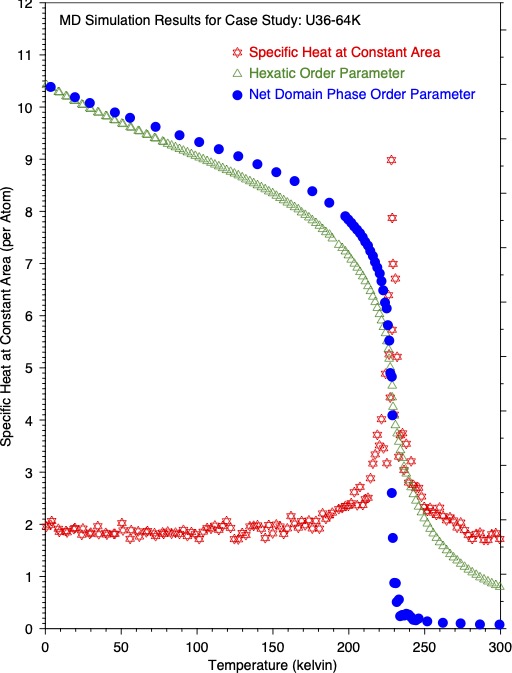 Incipient triple point for adsorbed xenon monolayers: Pt(111) versus graphite substratesAnthony D. Novaco, L. W. Bruch, Jessica BavarescoPhysical Review B 91, 161412 (2015)
Incipient triple point for adsorbed xenon monolayers: Pt(111) versus graphite substratesAnthony D. Novaco, L. W. Bruch, Jessica BavarescoPhysical Review B 91, 161412 (2015)Simulation evidence of an incipient triple point is reported for xenon submonolayers adsorbed on the (111) surface of platinum. This is in stark contrast to the ?normal? triple point found in simulations and experiments for xenon on the basal plane surface of graphite. The motions of the atoms in the surface plane are treated with standard 2D ?NVE? molecular dynamics simulations using modern interactions. The simulation evidence strongly suggests an incipient triple point in the 120–150 K range for adsorption on the Pt (111) surface while the adsorption on graphite shows a normal triple point at about 100 K.